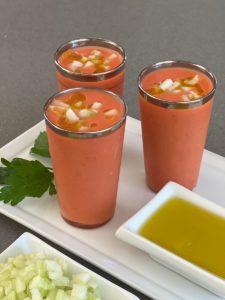Olive oil may have always been ubiquitous in some lucky American subcultures, but it wasn’t in mine. I remember the first time my mother ran across olive oil on an ingredient list. I don’t know what dish she was preparing, but I remember going with her to the grocery store in search of the unusual ingredient. It wasn’t shelved with the corn and vegetable oils we used for cooking. We found it on a shelf labeled “Ethnic Foods,” alongside canned refried beans and red-capped bottles of La Choy soy sauce. We left with one small conical bottle of Pompeian olive oil. That same bottle of oil was still sitting in our cupboard when I packed up for college years later.
Now, olive oil is everywhere. But not all of it is better than what was in that little bottle my mother bought in 1975.
The stuff isn’t called yellow gold for nothing. There’s a lot of money to be made from it, which explains why the market is flush with fake, old, and misrepresented oils. And while regulations have tightened since journalist Tom Mueller published his olive oil exposé Extra Virginity more than a decade ago, many experts are still dubious about the quality of what’s available on supermarket shelves.

The problem for most Americans outside California is that there’s no way to grow our own or count on a local farmer for our supplies. But here on Cape Cod we can know where our olive oil comes from. Sandwich-born Maria Lemanis and her Athens-born husband, Georgios Tselepis, sell their Monopati Farms unfiltered extra-virgin oil at farmers markets here. It is cold-pressed from olives harvested last season on their farm near the village of Pelekanada in the mountains of Kalamata.
Lemanis’s family has deep roots in Kalamata. She has always spent summers there, and, 15 years ago, she moved there for good. Sort of. She and Tselepis met in Athens, life happened, and now the two spend winters in Greece managing the harvest and overseeing the pressing, bottling, and exportation of their oil. They spend summers on the Cape and have been selling their oil here since 2013. Tselepis says that the duo move about one-half ton of oil each summer season.
Lemanis says she wants to embolden customers here to use the oil the ways the Greeks do. She’s not one for worrying about smoke points or special dipping oils. “There’s very little butter in southern Greece,” notes Lemanis. “We use olive oil, and we use it for everything.”
Olives and olive oil are, of course, Monopati’s bread and butter. But the farm’s proprietors noticed that Cape farmers markets aren’t just for food shopping — customers come to reconnect with friends and like to have a bite to eat during their visits. So, Tselepis, the baker in the family, started making Greek-style pastries to sell at their stand.
Their customers are drawn to items that are new and different, he says, but not too different. His baklava has been very popular, except the times he made it in unusual shapes. Now they always cut their baklava in triangles.
Standing under their canopy at the Truro Farmers’ Market, I ask Lemanis and Tselepis to tell me about the flavor of their oil. I want to hear their descriptions, but at the same time I’m braced for what I think is coming — floral notes and freshly mown grass — words that seem both esoteric and overused.
“Fresh,” is Lemanis’s reply. “Fresh is the best way I can describe it.” These two don’t put much stock in fanciful terms — to them, the oil’s specific flavors are subjective.
“Most of what you get in the supermarket is, well, old is the best thing I can say about it,” says Lemanis. She explains how oils marketed by large corporate players tend to be those that did not sell in the first year after production. And how, in the blending, repackaging, and time that follows, many oils lose their distinctiveness.
“This is fresh, small-production oil, and that’s what you taste,” says Lemanis.
As I leave the Truro Farmers’ Market with two bottles of 2022 Monopati Farms EVOO in hand,
I already know what I’m going to make with it. I have a surplus of cucumbers and some pretty good midseason tomatoes that, with a really vibrant olive oil, will become a wonderful gazpacho. It will be just the thing to serve chilled on a hot summer day.
The gazpacho I love is the kind Christopher and I discovered when we were traveling in southern Spain. There, it’s a concoction that falls somewhere between a drink and a soup. It is light and completely smooth, silky even, and is dependent on high-quality olive oil for its texture and flavor. It’s the color of an Andalusian sunset and tastes like summer. On that note, I’ve been known to mix in half an ounce of a spirit — like mezcal –– and serve it as an aperitif.
I don’t recommend making gazpacho if you can’t get good tomatoes. But in a pinch, it can work to supplement some fresh tomatoes with a few top-quality whole canned tomatoes to deepen the flavor of the soup.
While my recipe calls for the solids in the gazpacho to be strained out for perfect smoothness, if I’m in a hurry I skip this step. The gazpacho won’t be as silky, but it’s still delicious.
Lemanis and Tselepis sell their Monopati olive oil on Mondays from 8 a.m. to noon at the Truro Farmers’ Market and on Wednesdays from 8 a.m. to noon at Wellfleet’s.

Andalusian-Style Gazpacho
Makes about one quart
2 lbs. ripe tomatoes
1 Italian or Anaheim pepper
1 English cucumber, peeled
1 small sweet onion
1 clove garlic
3 tsp. sherry vinegar
2 tsp. salt
½ cup extra-virgin olive oil, plus more for drizzling
2 Tbsp. cucumber in small dice for garnish, if desired
Core the tomatoes and cut them in chunks. Do the same with the green pepper. Peel the onion and cut it into chunks. Peel and crush the garlic.
Combine prepped tomatoes, pepper, cucumber, onion, and garlic in a blender, working in batches, if necessary. Blend at high speed until very smooth (2 to 3 minutes). It may be necessary initially to press the vegetables into the path of the blade with a spatula. Pause occasionally to scrape down the sides if needed.
With the motor running, add the vinegar and 2 teaspoons salt. Slowly drizzle in the olive oil. The mixture will turn a bright orangey-pink and become smooth and emulsified, like a thin sauce.
If you want the gazpacho very refined, put the mixture through a strainer or a food mill, pushing all the liquid through with a spatula or the back of a ladle, and discard the solids. Chill until very cold, at least 4 hours or overnight. The gazpacho will keep in the refrigerator for 2 or 3 days.
Before serving, taste and adjust the salt and vinegar. If the soup is too thick, stir in a few tablespoons of ice water (or perhaps iced mezcal for a summer aperitif). Serve in small glasses or bowls. A few drops of olive oil and some small-diced cucumber on top are a nice touch.
